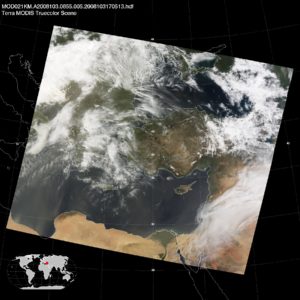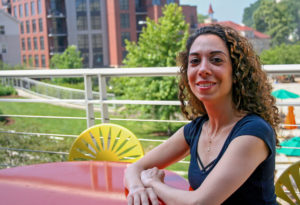At the crossroads: Turkish student studies Saharan dust from Wisconsin

The Moderate Resolution Imaging Spectroradiometer (MODIS) on NASA’s Terra satellite captured dust plumes blowing northeastward from North Africa toward Turkey on April 12, 2008. Credit: SSEC.
The Mediterranean region is a crossroads for wayfaring travelers, but it is also a crossroads for the intercontinental transport of air pollution that affects human health.
Particle pollution—more specifically, Sahara Desert dust particles that are swept across Northern Africa to every corner of the globe, including the Mediterranean Basin—is linked to cardiovascular and respiratory diseases in humans, says Burcu Kabataş, a Turkish graduate student from Istanbul Technical University (ITU).
Kabataş has been working with researchers at the University of Wisconsin-Madison Cooperative Institute for Meteorological Satellite Studies (CIMSS) and her graduate advisor Alper Ünal at ITU for the better part of a decade to learn more about applying the latest remote sensing techniques to study current environmental problems.
This June, along with earning her Ph.D., Kabataş was honored with the best dissertation award from ITU for her thesis titled, Quantification of Saharan Dust Influences on Eastern Mediterranean Air Quality via Atmospheric Modeling.
Dust that originates in the Sahara region, says Kabataş, is the largest naturally occurring source of particulate matter or particle pollution in the Eastern Mediterranean and Western Turkey. The fine bits of material, including grains of sand, that make up particulate matter (or PM10) are less than ten micrometers in diameter. If inhaled, they can cause serious health problems, especially in vulnerable populations like the very young and the very old.
“Other known sources of PM10 include industrial and vehicle emissions and burning coal,” says Kabataş. Teasing apart how much particle pollution is generated by dust and how much is anthropogenic, or contributed by man, and then, being able to accurately forecast it, is the crux of her research.
Kabataş constrained her study to April 2008, a month of unusually high readings of PM10 in Turkey. She retrieved surface air quality data from 118 stations across Turkey and compared it to satellite data across the region by using a computer model known as the Real-time Air Quality Modeling System (RAQMS). This global meteorological and chemical model was developed by NOAA scientist R. Bradley Pierce who is stationed at CIMSS and is Kabataş’s research advisor in Madison.
She incorporated aerosol and cloud data from the Moderate Resolution Imaging Spectroradiometer (MODIS) instrument onboard NASA’s Terra and Aqua polar orbiting satellites and the Cloud-Aerosol Lidar with Orthogonal Polarization (CALIOP) instrument on the U.S./French satellite, CALIPSO, another polar orbiting satellite.
CALIOP also provides key information on the altitude of aerosol layers, says Kabataş. Aerosols lofted higher in the atmosphere can travel farther—in this case, from the Sahara to Turkey.

Burcu Kabataş. Credit: Eric Verbeten, SSEC.
Building on the RAQMS results, and to further analyze the April 2008 dust storm, Kabataş used a higher resolution regional Weather Research and Forecasting (WRF-Chem) model designed for chemical analysis along with the NOAA Gridpoint Statistical Interpolation (GSI) data system to assimilate the MODIS aerosol optical data. Hers is the first study to assimilate or aggregate observations with the WRF-Chem system to investigate natural dust influences on air quality over the Anatolian Peninsula, which makes up most of Turkey.
By assimilating satellite observations into atmospheric modeling systems, says Kabataş, “I could generate a picture of the atmospheric aerosols to get a sense of PM10 distribution and concentration over Turkey and eventually, for other locations around the globe.”
When comparing the model data to the ground observations, notes Kabataş, “we found that the temporal and spatial distribution of PM10 seems to be correct and we are continuing our research to improve the representation of planetary boundary layer dynamics in order to make better predictions.”
Kabataş concluded that the time of year may influence PM10 levels. PM10 concentrations tend to be higher during cold seasons when the boundary layer height is low and sources of pollution, other than dust, are higher. In addition, Sahara dust outbreaks are more likely to occur in the transition from one season to another, as in the outbreak of April 2008.
Other countries in the region with dust transport problems are interested in Kabataş’s portable air quality forecasting system.
“By changing the domain from Turkey to another country, we can run the same model,” says Kabataş. “I love how the model works, how efficient it is, and that it can help other people.” Better and more accurate forecasting of dust events will give advanced warning to those with asthma, cardiovascular disease, and other health issues.
Dust is a natural source contributing to high levels of PM10 in Turkey and other regions, and cannot be prevented. However, says Kabataş, we can, and must, work on anthropogenic emissions, too. Through this model, she adds, we can let people know what we are seeing, and at the same time, begin to impress upon decision makers the necessity of addressing climate change.
Kabataş started down this research path thanks to CIMSS senior scientists Paul Menzel and Liam Gumley, who introduced her to Pierce, all three of whom “are like secret heroes of my life,” she says.
Kabataş met Menzel and Gumley at a remote sensing seminar they taught in Benevento, Italy in 2007 when she was an undergraduate engineering student. Inspired by them, she opted for a new course of study: satellite remote sensing. Menzel later invited Kabataş to come to Madison where he served as advisor for her master’s degree.
“Meeting Paul changed my life,” she says. “I remember him saying to me, ‘When you see a fork in the road, take it.’ I did. And it brought me to Madison. I am very thankful for that.”
This research was supported by the National Aeronautics and Space Administration (NASA) under grant number NNX13AOO9G and the Scientific and Technological Research Council of Turkey (TUBITAK) under grant number 111G037.
By Jean Phillips
